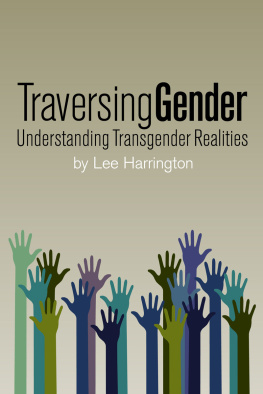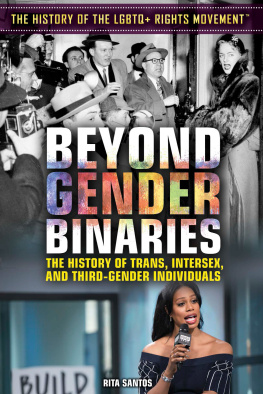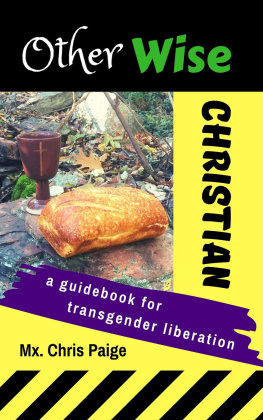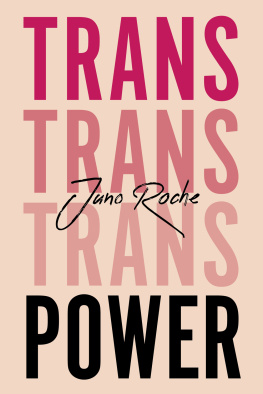Advance Praise for Trans
This provocative and perceptive book argues that the current trans moment presents an unparalleled opportunity for exploring vernacular classification systems and political claims about identities. Transposing and generalizing to the arena of race and ethnicity insights developed by transgender and feminist analysts, Trans reveals the paradoxical deployment of social construction, contingency, and biology.
Ann Shola Orloff , Northwestern University
Taking up Caitlyn Jenners gender transition and Rachel Dolezals status as a self-proclaimed black person, Brubaker sheds light on the paradoxes of choice and constraint that swirl around conceptions of identity at a time when our cultural understandings of gender and race are very much in flux. This is a timely, judicious, and tremendously thoughtful and learned investigation into present-day debates. Everyone will want to read this book.
Steven Epstein , author of Inclusion: The Politics of Difference in Medical Research
Trans provides an exceptionally lucid, insightful account of the contemporary discussion on trans and an extremely useful investigation of the directions that transgenderism and transracialism might take. Offering original thinking about gender to prod us to consider race in new ways, this dauntingly good book will garner a great deal of attention.
Ann Morning , author of The Nature of Race: How Scientists Think and Teach about Human Difference
Trans provides a strong, nuanced perspective on the rapidly shifting cultural imaginary of transgender identities and the emerging questions about possibilities for transracial identification. In its analysis of how popular thinking on race aligns and diverges from beliefs about gender, this timely book will engender much discussion and perhaps some controversybut it will definitely be read.
Kristen Schilt , University of Chicago
trans
Gender and Race in an Age of Unsettled Identities
Rogers Brubaker
Princeton University Press
Princeton and Oxford
Copyright 2016 by Princeton University Press
Published by Princeton University Press, 41 William Street, Princeton, New Jersey 08540
In the United Kingdom: Princeton University Press, 6 Oxford Street, Woodstock, Oxfordshire OX20 1TR
press.princeton.edu
All Rights Reserved
ISBN 978-0-691-17235-4
Library of Congress Control Number: 2016936750
British Library Cataloging-in-Publication Data is available
This book has been composed in Sabon Next LT Pro
Printed on acid-free paper.
Printed in the United States of America
1 3 5 7 9 10 8 6 4 2
In memory of
Allan Silver
Contents
Preface
This is a book that took me by surprise. In June 2015, as UCLAs spring quarter was drawing to a close, I was settling in for a summers work on a longstanding book project on the politics of religious and linguistic pluralism when my attention was drawn to the pairing of transgender and transracial in debates about whether Caitlyn Jenner could legitimately identify as a woman and Rachel Dolezal as black. The provocative pairing generated an unusual moment of vernacular sociology: a contentious, sprawling, multistranded public seminar about the contemporary meanings and workings of gender and racial identities. For a week, until the fickle spotlight of public attention moved on, the mainstream media, the blogosphere, and social media were abuzz with discussions not only about Jenner and Dolezal but about the similarities and differences between gender and race, the ways in which gender and racial identities were naturally given or socially constructed, and the possibilities for choosing and changing gender and racial identities.
I found these debates interesting, revealing, andsurprisingly oftenmoving (though of course much of the online commentary was crude, narrow-minded, and riddled Analysis was largely subordinated to efforts to validate or invalidate the identities claimed by Jenner and Dolezal.
Reflecting on the initial round of commentary, Susan Stryker, a leading figure in transgender studies, urged scholars to hold open a space for real intellectual curiosity, for investigations that deepen our understanding of how identity claims and processes function, rather than rushing to offer well-formed opinions based on what we already think we know. It is in this spirit that I have written this book. The controversy that swirled around Jenner and Dolezal serves as a useful point of entry into my subject. But I step back from that controversy in order to analyze the deep tensionsbetween chosenness and givenness, self-transformation and social constraintthat structure contemporary understandings of gender and race.
This is an essay, not a monograph, and it has (I hope) some of the virtues as well as the limitations of that genre. An essay is by definition exploratory, tentative, and incomplete. It is a means of thinking on paper, of trying things out in writing, as Carl Klaus has observed. Even when it is more disciplined than Samuel Johnsons loose sally of the mind, an irregular indigested piece, the essay remainsas suggested by the original meaning of the word, a process of trying or testing an open-ended experiment, a means of trying out new ideas and exploring new territory. The essay offers a degree of freedom that the monograph does not.
The limitations of the essay formlimitations of depth, systematicity, and definitivenessare evident enough. To these must be added the limitations of the author. The book is not just an essay; it is an essay in trespassing, to borrow Albert Hirschmans wonderful title. My previous work has touched only glancingly on gender and not at all on transgender issues. And while I have written at length on ethnicity, argued for an integrated analysis of race, ethnicity, and nationalism, and analyzed the return of biology in the theory and practice of race and ethnicity, my work has not been centrally concerned with race per se.
An outsider who wades into conceptual and political thickets as densely controversial as these can scarcely hope to emerge unscathed. Yet writing as an outsider may offer certain advantages. As a comparativist with broad interests in the workings of identity categories and the politics of difference, I hope that the intellectual friction generated by thinking about sex and gender in relation to race and ethnicity may prove productive rather than reductive: I hope that it may suggest ways of going beyond misleading equivalencies and ready-at-hand analogies to a richer and more nuanced understanding of both similarities and differences.
I am an outsider not only to the fields of gender and transgender studies but also to the experience of crossing gender or racial boundaries. My analysis is no doubt shaped and limited by my own identity as a white cisgender male. But my primary interest in the book is not in the lived experience of those who move between gender or racial categories or position themselves between or beyond such categories. It is rather in the contemporary transformations of, and struggles over, gender and race as systems of social classification. An ample literature describes the experiences of those engaged in these transformations and struggles; I have learned a great deal from it. But I seek in this book to provide a broader account, one that is necessarily more distant from lived experience.
The book is addressed to all who are interested in contemporary transformations of identity, not simply those with a special interest in race or gender. To make the argument accessible to a wide readership, I have sought to avoid academic jargon as much as possible. At the same time, however, I have tried not to oversimplify complex issues. I have made ample use of notesfor the most part endnotes, but a handful of footnotes as wellto qualify, illustrate, and extend the argument without encumbering the main text. Sources are cited in the notes by author and date only; full publication details can be found in the bibliography.
Next page







